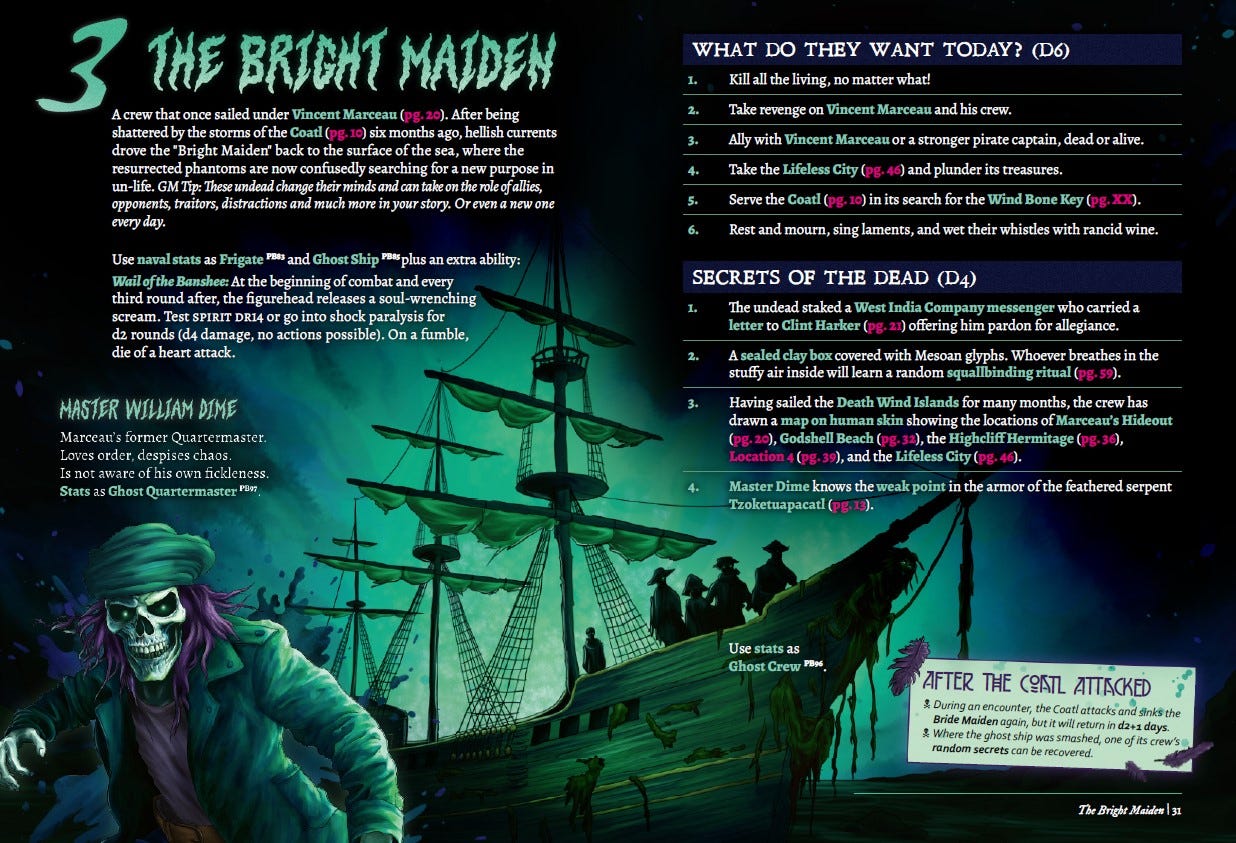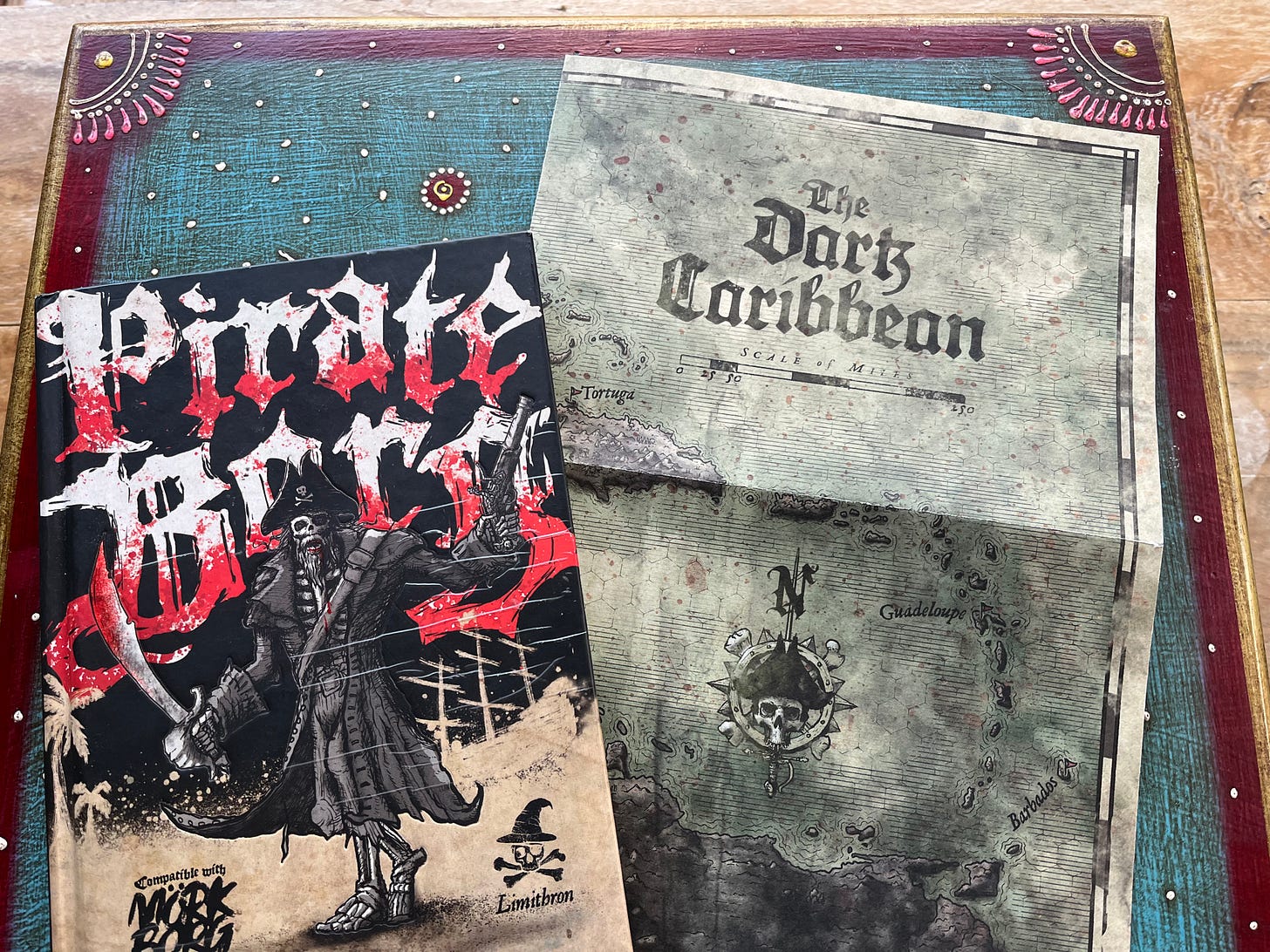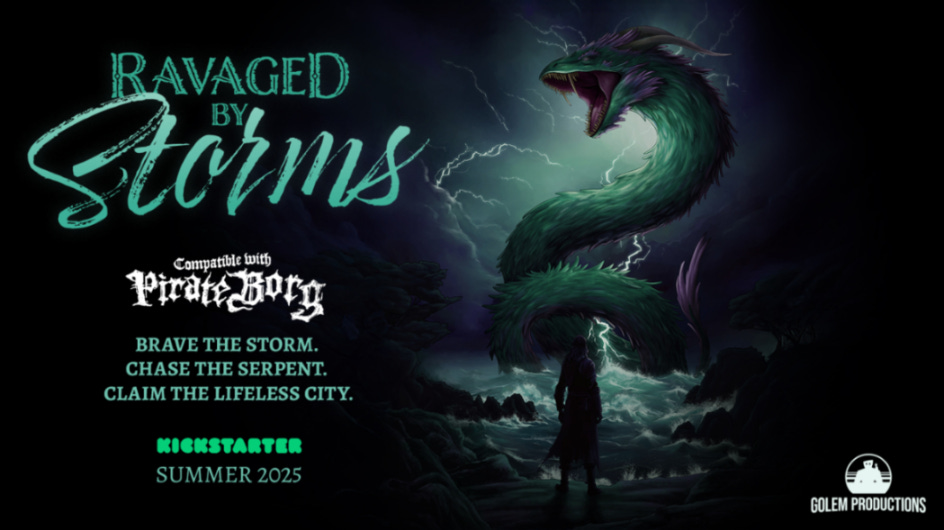From Idea to Adventure
#008 - A sneak peek into RAVAGED BY STORMS for Pirate Borg
BRAVE THE STORM. CHASE THE SERPENT. CLAIM THE LIFELESS CITY.
Long ago, in the days of ancient Mesoa, people were said to conspire with the forces of nature and to walk alongside the gods of wind and sea. Back then, mythical beasts like the feathered serpents of old have allegedly lived in harmony with human beings. Of course, such stories are dismissed as legends, romantic nonsense at best.
But are they?
Sailors in The Dark Caribbean whisper of something real, a feathered serpent coiled in storm clouds, guarding a forgotten island in the Eastern Bahamas. An unnatural Coatl with the power to call upon terrible storms is said to block passage to an ancient city, built by unknown people with white stone. They say no ship may pass. That something waits there. That treasures lie in the bones of a dead city RAVAGED BY STORMS.
Behind the Adventure: Writing Ravaged by Storms
This post is a sneak preview to our upcoming adventure and how I went about writing it. And this is one of its main NPCs:

Ravaged by Storms is an upcoming 72-page sandbox adventure module by Golem Productions designed for Pirate Borg, but easily adaptable to many other OSR systems. With this post, you’ll learn what you and your players can expect from it. It will give you a clear idea of the direction we are heading in.
Writing Adventures: In the beginning there was a spark
Every adventure I’ve written so far started as a faint spark somewhere in my mind. More like the hint of an image than a concrete idea, often accompanied by a mood, a vibe. I can't control when this creative spark ignites, but it often happens when I’m listening to music or going for a walk (or doing both). The important thing is that I act on it soon. It would be an exaggeration to call the urge a pain, but when I feel such a creative vision sprouting, I realize very clearly that it wants to be seen.
And when I follow the breadcrumbs, it sometimes unfolds into living scenes that play out like a movie in my mind’s eye, into words I hear, or other imaginative experiences. Perhaps you too can learn to follow such a vague idea that quietly suggests itself.
This may all sound a little elusive, but it’s really how the process feels to me. For the first adventure my sister and I published – The Way of the Worm – the spark was a cave on an island with a mountain, from which a menacing creature was manipulating the islanders. For The Scarlet Coral Citadel, it was the image of a scarlet coral that was so large it rose out of the sea. And that’s how it each began. I just started writing on any page of the adventure close to the original spark, and from there, one thing led to another. So, even if you only have a rough idea in your mind, it might be worth exploring.
Foundations of Ravaged by Storms
With Ravaged by Storms, the writing process was a little different, if only because it’s a much bigger project that we had a lot more time to work on. We (me and my sister Sabrina, who is responsible for our graphic design, but also brings the spark to life visually) carefully planned our pages and spreads and kept reworking them until we were happy with the result. Sabrina has blogged about how we went about designing the layout of one of our previous adventures before. We would discuss concepts and how to balance wealth of content, clarity, and usability, for example. Anyway, there was an initial image, a spark that started it all:
I wanted to write a sandbox adventure in which players could move around freely with their ship, chasing a goal while under time pressure and surrounded by competition. At the same time, I had this idea of a monster that also moved dynamically through the game world and influenced the setting.Both of these basic ideas ultimately made it into the adventure:
For one, the adventure features the Death Wind Islands, a remote archipelago located in the Eastern Bahamas fought over by a mythical Coatl and 3 human factions. It will be completely up to your players to decide if or how they are going to interact with them.
All these factions are going to pursue a certain goal and things will (really) go south if that goal isn’t reached by anyone in time. A suggested introductory scene will provide your players with a starting point for exploring the same goal. But this is OSR: there is no prescribed plot!
There are going to be rumors, encounter tables, NPCs, (optional) plot hooks, etc. as you would expect, but we also offer travel procedures which include dynamic faction activities to breathe life onto the setting.
And what do all of our published adventures have in common so far? They were designed for Pirate Borg. Why’s that? Let’s take a look.
What is Pirate Borg and why are we writing for it?
Pirate Borg by Limithron (and soon to be released in German by System Matters) is where it all started for us, as we have described in this post about the history of Golem Productions. We do have ideas for supporting other games and even for games and hacks of our own, but at the moment we’re proud to be among those leading the charge in 3PP for the best swashbuckling, scurvy-ridden pirate OSR game you perhaps never knew you needed.
Ever wondered what Pirates of the Caribbean would be like if it weren’t a movie for kids? Pirate Borg nails that vibe, mixing swashbuckling fun with snorting zombie dust and other outrageous fantasy-horror twists. It’s a very accessible, rules-light Mörg Borg hack, but tilt strongly in the direction of OSR games more closely related to classic D&D like Old-School-Essentials or the gaming philosophies of Mothership compared to most other Borg hacks that I know.
With its creative tables, a steady flow of new content, over-the-top tone, quick rules, and rock-solid support network, Pirate Borg makes it easy to play a pirate and nearly impossible to stop. That said, I was maybe even more impressed with the author’s ethics. Let me quote the core book:
"Pirate Borg is a game about grog-swilling pirates, undead galleons, arcane treasures found in ancient temples, and high seas adventure. It’s not a game about slavery, sexual violence, genocide, or any of the other abhorrent real parts of our history. Please treat these topics with the respect they deserve, or leave them out of the game altogether and go hunt some skeletons."
Although recent publications acknowledge that, in addition to its swashbuckling and lighthearted version, the game can certainly be played as a grimdark horror game or for historical-political campaigns à la Master & Commander or Black Sails, I admire and appreciate the author's decision not to let players wallow in the atrocities of our real world, but instead to create a fun, quick-to-play adventure game for everyone. I often wonder whether the TTRPG scene has a grimdark problem – I’ll devote a blog article to this in the future – and of course, Pirate Borg also has its share of bloody conflicts. However, it doesn’t revel in them, which is something I really appreciate about the game.
So, if you’ve ever wanted to hoist the black flag and dive into a wild, undead-infested Caribbean sandbox, this game delivers the most fun you can have short of actually stealing a ship (which Golem Productions neither recommends nor encourages nor tolerates, just to be clear ;) ).

Further sources of inspiration
As we all know, no text is created in a vacuum without being influenced by other texts. This is naturally also the case here. Here are some adventures and settings that I found particularly inspiring for our project. They have impressed me with their well-designed sandbox environments, their thoughtfully interconnected set pieces, which exude adventure and a sense of exploration (I’ve blogged about how I feel a sense for exploration is essential for OSR).
To further improve interconnections between all components for my next adventures, I will try to apply Luke Gearing’s snowball method of writing adventures, as exemplified by his blog post about writing Wages of Sin.
They are all worth picking up and impress with their ability to go far beyond the linear hack‘n’slash gameplay that is all too common in introductory adventures for Borg games, among others.
The Curse of Skeleton Point by Luke Stratton (Pirate Borg)
The Desert Moon of Karth by Joel Hines (Mothership)
Secret of the Black Crag by Chance Dudinack (Old-School Essentials)
A Pound of Flesh by Sean McCoy et.al. (Mothership)
The Electrum Archive by Emiel Boven and Ava Islam
Jade Colossus: Ruins of the Prior Worlds by Bruce R. Cordell (Numenéra).
This brief preview should give you a clear idea of the direction Ravaged by Storms is heading in. More details and visuals will be shared in the future, before we brave the storm on Kickstarter this Summer 2025.
This post only scratched the surface of Ravaged by Storms. In the coming weeks, I’ll be sharing design breakdowns of specific locations, showing off Sabrina’s incredible art, and diving into how Ravaged by Storms is fueled by the spirit of the OSR—community-driven, open-ended, and a little dangerous. If that excites you, follow us, subscribe, we’d love to have you aboard.
“From pebble to monolith—your journey matters. The Golems have spoken.”
Alexander from Golem Productions




